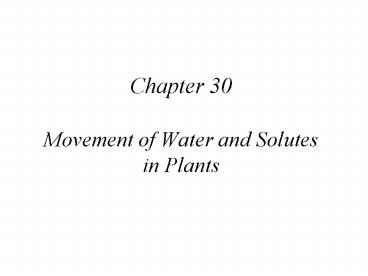Chapter 30 Movement of Water and Solutes in Plants - PowerPoint PPT Presentation
1 / 14
Title:
Chapter 30 Movement of Water and Solutes in Plants
Description:
evaporation of water from CW surface to airspaces w/i leaf. diffusion of water vapor from air space into atm. ... Dendrometer. measures change in trunk diameter ... – PowerPoint PPT presentation
Number of Views:221
Avg rating:3.0/5.0
Title: Chapter 30 Movement of Water and Solutes in Plants
1
Chapter 30Movement of Water and Solutes
in Plants
2
Basics
- Water movement in X (upward)
- taken up by roots
- evaporated from lvs/non-woody stems
- transpiration (T) evaporation of water from
plant - 2 steps
- evaporation of water from CW surface to airspaces
w/i leaf - diffusion of water vapor from air space into atm.
- as water moves from leaf, more pulled up from
roots via X - controlled by stomata
- Photosynthate (sugar) mvmt in P (downward)
- source-sink (lvs to roots)
- sugar removed 1st, followed by water
3
Water and Nutrient Movement
- Plants utilize more water than animals per wt
- animals recirculate
- plants have 1-way path from root to shoot (99
loss) - deciduous tree transpires 50-100 G/day
- unavoidable evil
- balance water loss w/
CO2
acquisition via stomata - cuticle leaf covering,
impervious to
water and CO2
4
Stomata
- Stomata pores in leaf surface
- bordered by guard cells
- used to regulate water loss and CO2 intake
(12,000/cm2) - some water loss via lenticels
- interior of stomata is spongy mesophyll
- lots of air space
- ? humidity
5
Stomata
- Turgor pressure pressure due to water mvmt into
cell - Turgor pressure in guard cells determines
stomatal aperture - determined by mvmt of water into and out of leaf
along ?w gradient dictated by solutes - solutes actively ? in guard cells
- water moves into cell stomata open
- solute conc. ?
- water moves out of cell
stomata close
6
Stomata
- Factors affecting stomatal aperture
- water loss/gain
- abscisic acid (ABA)
- produced in roots/mesophyll cells
- ? ABA close
- circadian rhythms
- light open, dark close
- CAM plants are opposite
- ?CO2 close, ?CO2 open
- ? temp. close
- ? temp ? respiration ?CO2
7
Transpiration Rates
- Transpiration
- doubles every 10C ?, up to 35C when stomata close
- Humidity
- T rate proportional to VPD
- T ? w/ ? humidity
- relates to leaf morphology
- Air current/wind
- boundary layer
- thick boundary layer ? T
- blow humid air away from leaf surface
- cooling
- drying
8
Cohesion-Tension Theory
- Sequence of events
- water evaporates from CW surfaces of air spaces
w/i leaf and replaced by water w/i cell - due to loss of water, solute conc. ? w/i cell
- ?w ?
- water moves from adjacent cells w/ ? ?w
- continuum of ?w throughout plant
- ? ?w due to T results in gradient from
atmosphere to soil via
plant tissues - H-bonding allows water pulled
up through plant - cohesive properties
- allows water to be pulled (tension)
- adhesive properties
- X walls attract water
9
Cavitations and Embolisms
- Upward transport of water depends on continuous
water column - Cavitation breakdown of
continuous water column - Embolism filling of X element
w/ air bubble - cannot conduct water
- large vessels most susceptible
- due to physical damage
- insect/breakage/freezing
- airseeding air sucked in
from adjacent X
element - larger pores more susceptible
10
Cavitations and Embolisms
- Pit membranes help prevent cavitation of entire
column - keep it localized
- due to surface tension btwn air/water
meniscus in tiny pores
of pit membranes
or blocked by torus
11
Measurements
- Pressure bomb/chamber
- measures tension in leaf/twig
- when plant organ removed, water retracts
- apply pressure until sap comes to
surface of cut plant part - pressure applied tension in plant
12
Measurements
- Dendrometer
- measures change in trunk diameter
- delay in skrinkage in lower trunk relative to
higher on trunk - Sap flow gauge
- measures water flow past specific pt
- heating element/thermocouple used to determine
rate of T - 16 - 45m/day in trees
w/ wide
vessels - 1- 6m/day in trees
w/ narrow
vessels
13
Water Entry
- Root hair functions
- anchorage
- important for water uptake
- greatly ? SA, greater contact
- Pathways for water entry
- apoplastic btwn cells via CW
- symplastic btwn protoplast via
plasmodesmata - transcellular cell to cell,
vacuole to
vacuole
14
Root Pressure and Hydraulic Lift
- Root pressure pressure in roots due
to excessive osmosis of
water into X
when T is low - guttation exudation of water
from hydathodes - stomata cant close on leaf margins
- water exudation from wounds/stumps
- Hydraulic lift txf water from moist area in
soil to dry areas via
plant roots - good for smaller, adjacent plants w/o
deep root systems - desert plants































